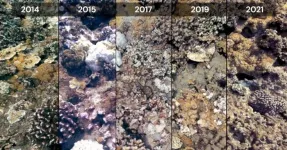(Press-News.org) ANN ARBOR—Shortly after an asteroid slammed into Earth 66 million years ago, life for non-avian dinosaurs ended, but the evolutionary story for the early ancestors of birds began.
The fossil record tells us that the early ancestors of living birds began their evolutionary journey just after the mass extinction event caused by the asteroid, but researchers weren't sure how they would see that story reflected in bird genomes. Now, a University of Michigan study has identified important changes in birds' genomes sparked by the mass extinction, called the end-Cretaceous mass extinction event, ultimately contributing to the incredible diversity of living birds.
The study examined the evolutionary trajectory of all major bird groups and found evidence of "genomic fossils" in birds' DNA that mark critical evolutionary steps as birds evolved into more than 10,000 living species. The research is published as an open-access article in the journal Science Advances.
"By studying the DNA of living birds, we can try to detect patterns of genetic sequences that changed just after one of the most important events in Earth's history," said lead author Jake Berv, who completed the study as a Michigan Life Sciences Fellow in the U-M Department of Ecology and Evolutionary Biology. "The signature of those events seems to have imprinted into the genomes of the survivors in a way that we can detect tens of millions of years later."
A living organism's genome comprises four nucleotide molecules, referred to by the letters A, T, G and C. The order of these nucleotides in a genome defines the "blueprint" of life. The DNA code can sometimes evolve in a way that shifts the overall composition of DNA nucleotides across the whole genome. These compositional changes are crucial in determining what kind of genetic variation is possible, contributing to an organism's evolutionary potential, or its ability to evolve.
The researchers found that the mass extinction event sparked shifts in nucleotide composition. They also found that these shifts seem to be connected to the way birds develop as babies, their adult size and their metabolism.
For example, within approximately 3 million to 5 million years of the mass extinction, surviving bird lineages tended to develop smaller body sizes. They also changed how they developed as hatchlings, with more species becoming "altricial." This means they are still very embryonic when they hatch, need their parents to feed them, and can take weeks to fledge, Berv says. Birds that hatch ready to fend for themselves, like chickens and turkeys, are called "precocial."
"We found that adult body size and patterns of pre-hatching development are two important features of bird biology we can link to the genetic changes we're detecting," said Berv, now a Schmidt AI in Science postdoctoral fellow with U-M's Michigan Institute for Data & AI in Society.
Berv says one of the most significant challenges in evolutionary biology and ornithology is teasing out the relationships between major bird groups—it's difficult to determine the structure of the tree of life for living birds. Over the past 15 years, researchers have been applying increasingly large genomic data sets to try to solve the problem.
Previously, researchers used genomic data to study the evolution of birds' genomes using statistical models that make strong assumptions. These "traditional" models allow researchers to reconstruct the history of genetic changes, but they typically assume that the composition of DNA, its proportion of A, T, G and C nucleotides, does not change across evolutionary history.
In late 2019, Berv began working with Stephen Smith, U-M professor of ecology and evolutionary biology, who was developing a software tool to more closely track DNA composition over time and across different branches of the tree of life. With this tool, the researchers were able to relax the assumption that the composition of DNA remains constant. Smith said that this allowed the "model" of DNA evolution to vary across the evolutionary tree and identify places where there was likely a shift in DNA composition.
For this new research, these shifts were concentrated in time, within about 5 million years of the end-Cretaceous mass extinction, Berv says. Their approach also allowed them to estimate which bird traits were most closely associated with these shifts in DNA composition.
"This is an important type of genetic change that we think we can link to the mass extinction event," he said. "As far as we know, changes in DNA composition have not been previously associated with the end-Cretaceous mass extinction in such a clear way."
Daniel Field, professor of vertebrate paleontology at the University of Cambridge and co-author of the study, has been interested in understanding how the end-Cretaceous mass extinction affected the evolution of birds. He provided guidance related to early bird evolution following the mass extinction.
"We know that mass extinction events can dramatically affect biodiversity, ecology and organismal form. Our study emphasizes that these extinction events can actually influence organismal biology even more profoundly—by altering important aspects of how genomes evolve," Field said. "This work furthers our understanding of the dramatic biological impacts of mass extinction events and highlights that the mass extinction that wiped out the giant dinosaurs was one of the most biologically impactful events in the entire history of our planet."
The researchers say that by relaxing the typical assumptions used in evolutionary biology, they are building more nuanced insight into the sequence of events that occurred in the early history of birds.
"We have typically not looked at the change in DNA composition and model across the tree of life as a change that something interesting has happened at a particular point of time and place," Smith said. "This study illustrates that we have probably been missing something."
U-M co-authors include Benjamin Winger, assistant professor of ecology and evolutionary biology and curator of birds at the U-M Museum of Zoology, and Matt Friedman, professor of earth and environmental sciences and director of the U-M Museum of Paleontology.
Other study co-authors include Sonal Singhal, California State University; Nathanael Walker-Hale, University of Cambridge; Sean McHugh, Washington University; J. Ryan Shipley, Swiss Federal Institute for Forest, Snow and Landscape Research; Eliot Miller, Cornell Lab of Ornithology; Rebecca Kimball and Edward Braun, University of Florida; Alex Dornburg, University of North Carolina; C. Tomomi Parins-Fukuchi, University of Toronto; and Richard Prum, Yale University.
END
Mass extinction 66 million years ago triggered rapid evolution of bird genomes
2024-07-31
ELSE PRESS RELEASES FROM THIS DATE:
The next generation of RNA chips
2024-07-31
An international research team led by the University of Vienna has succeeded in developing a new version of RNA building blocks with higher chemical reactivity and photosensitivity. This can significantly reduce the production time of RNA chips used in biotechnological and medical research. The chemical synthesis of these chips is now twice as fast and seven times more efficient. The results of the research were recently published in the prestigious journal Science Advances.
The emergence and approval of RNA-based medical products, such as mRNA vaccines during the COVID-19 pandemic, has brought the RNA molecule ...
3D models provide unprecedented look at corals’ response to bleaching events
2024-07-31
In a new study, marine biologists from Scripps Institution of Oceanography at UC San Diego and Arizona State University are providing a first-of-its-kind glimpse into coral “bleaching” responses to stress, using imaging technology to pinpoint coral survival rates following multiple bleaching events off the island of Maui. Their findings were published July 31 in the journal PLOS ONE.
Using a time series of coral reef 3D models from Maui, a team of researchers led by Scripps Oceanography’s Smith Lab tracked the bleaching response of 1,832 coral colonies from 2014 to ...
Study finds White Western women have lower body appreciation and greater media pressure to look thin
2024-07-31
White Western women have lower body appreciation and experience greater pressure from the media to be thin compared to Black Nigerian and Chinese women across all ages, according to new research.
The study, carried out by psychologists at Durham University (UK), and published in PLOS ONE, explored the impacts of age and sociocultural pressures on body appreciation (feelings of positivity and pride about one’s body) amongst White Western, Black Nigerian and Chinese women.
Whilst all three groups had relatively stable body appreciation across ages, there were significant cultural differences.
White ...
Underwater mapping reveals new insights into melting of Antarctica's ice shelves
2024-07-31
Clues to future sea level rise have been revealed by the first detailed maps of the underside of a floating ice shelf in Antarctica.
An international research team - including scientists from the University of East Anglia (UEA) - deployed an unmanned submersible beneath the Dotson Ice Shelf in West Antarctica.
The underwater vehicle, ‘Ran’, was programmed to dive into the cavity of the 350metre-thick ice shelf and scan the ice above it with an advanced sonar. Over 27 days, the submarine travelled more than 1000 kilometres back and forth under the shelf, reaching 17 kilometres into the cavity.
An ice shelf is a mass of glacial ice, fed from land by tributary glaciers, that ...
AI creates cardiology reports for patients
2024-07-31
An artificial intelligence program created explanations of heart test results that were in most cases accurate, relevant, and easy to understand by patients, a new study finds.
The study addressed the echocardiogram (echo), which uses sound waves to create pictures of blood flowing through the heart’s chambers and valves. Echo reports include machine-generated numerical measures of function, as well as comments from the interpreting cardiologist on the heart’s size, the pressure in its vessels, and tissue thickness, which can signal the presence of disease. In the form typically generated by doctors, the reports are difficult for ...
Nasal COVID-19 vaccine halts transmission
2024-07-31
The lightning-fast development of COVID-19 vaccines just months after the virus appeared was a triumph of modern science and saved millions of lives. But for all the good they did in reducing illnesses and deaths, the shots were unable to end the pandemic because of one notable weakness: They couldn’t stop the spread of the virus.
A new study by researchers at Washington University School of Medicine in St. Louis indicates that next-generation vaccines that target the virus’s points of entry — the nose and mouth — may be able to do what traditional shots cannot: contain the spread of respiratory infections and prevent transmission. ...
Downwind states face disproportionate burden of air pollution
2024-07-31
A recent Supreme Court decision to block a federal rule curbing interstate air pollution further complicates efforts to reduce emissions and adds to an already disproportionate burden on “downwind” states, according to researchers at the University of Notre Dame.
“Toxic air pollution is really not as well known by the general public as you would hope, given its impact on human health,” said Paola Crippa, assistant professor in the Department of Civil and Environmental Engineering and Earth Sciences. ...
Barriers designed to prevent saltwater intrusion may worsen inland flooding
2024-07-31
As Earth continues to warm, sea levels have risen at an accelerating rate – from 1.4 millimeters a year to 3.6 millimeters a year between 2000 and 2015. Flooding will inevitably worsen, particularly in low-lying coastal regions, where more than a billion people are estimated to live. Solutions are needed to protect homes, property and groundwater from flooding and the intrusion of saltwater.
Seawalls and similar infrastructure are obvious options to protect against flooding. In fact, cities such as New York and San Franciso have already thrashed out potential plans with the Army Corps of Engineers that will heavily rely ...
Vaping and smoking together increases lung cancer risk fourfold
2024-07-31
COLUMBUS, Ohio – People who both vape and smoke are four times more likely to develop lung cancer than people who just smoke, according to new study published by The Ohio State University Comprehensive Cancer Center – Arthur G. James Cancer Hospital and Richard J. Solove Research Institute (OSUCCC – James) and College of Public Health. These findings were consistent across gender and race.
This is the first study to provide evidence that smoking in combination with vaping increases the risk for cancer compared to smoking alone. Researchers ...
Scientists discover unexpected behavior in dimers of CO₂ molecules after ionization
2024-07-31
A team of international scientists has unveiled a surprising discovery in molecular physics, revealing unexpected symmetry-breaking dynamics in ionized carbon dioxide dimers. Published in Nature Communications, the study provides new insights into the structural changes that occur when these molecular clusters are exposed to extreme ultraviolet (EUV) radiation.
An international team of scientists, led by Profs. Daniel Strasser and Roi Baer from The Hebrew University of Jerusalem, has made an important discovery in molecular physics, revealing unexpected symmetry-breaking dynamics in ionized carbon dioxide dimers. Published in Nature Communications, ...



